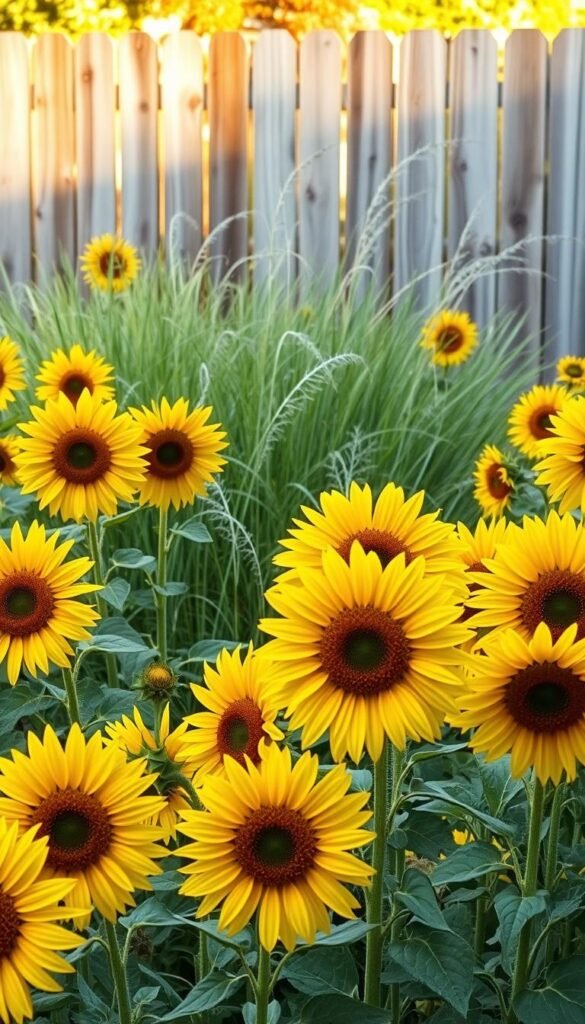These golden-flowered marvels do more than just turn heads. Their dinner-plate-sized blossoms act as living solar panels, following the sun’s path while creating dynamic focal points in any setting. Whether you’re working with patio containers or open fields, these plants adapt effortlessly to your space.
Beyond their visual drama, they serve as buzzing hubs for bees and butterflies. Many varieties produce edible seeds that nourish both people and birds through colder months. Taller types form living curtains, offering temporary privacy from neighboring views.
What makes these radiant plants truly special is their forgiving nature. They thrive in various soil conditions and require minimal pampering. From compact dwarf types to sky-reaching varieties reaching 12 feet, there’s a perfect match for every landscape vision.
You’ll soon discover how simple adjustments in placement and care can maximize their impact. We’ll guide you through selecting ideal varieties, strategic planting techniques, and creative ways to enjoy their seasonal magic. Let’s unlock the full potential of these sunny ambassadors in your personal slice of nature.
Getting Started: Choosing the Best Location and Soil for Sunflowers
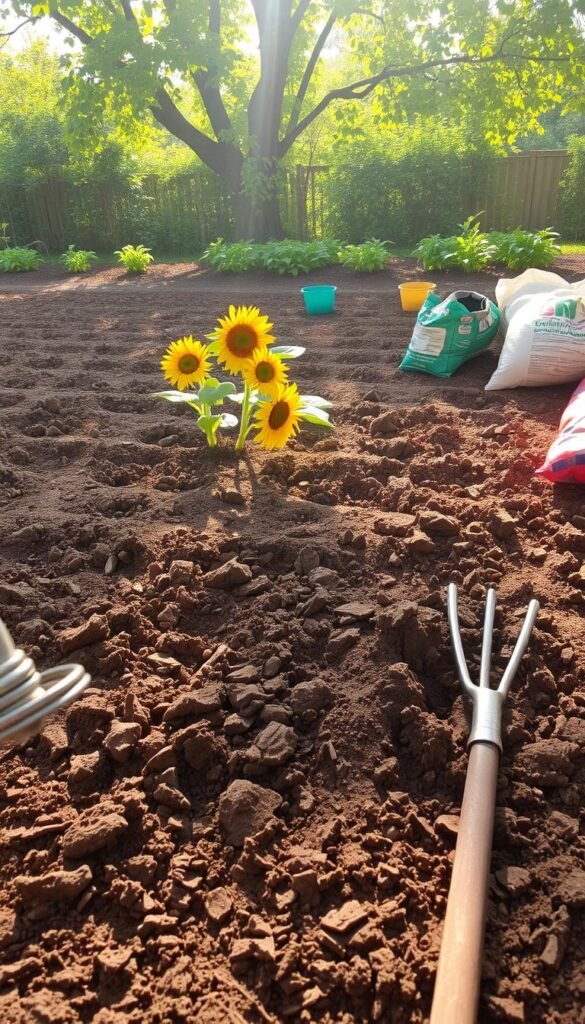
Positioning your plants correctly sets the stage for success. The right combination of light exposure and earth quality determines whether you’ll get stunted stems or towering blooms bursting with color.
Understanding Sunlight Requirements
Your sun-worshipping plants demand generous daily light portions. Aim for locations receiving 6-8 hours of direct rays – preferably morning sunshine with dappled afternoon shade in hotter regions. This balance prevents wilting while fueling vigorous growth.
Trackers (varieties that follow the sun) perform best when planted on your garden’s eastern edge. Their faces will pivot westward as daylight progresses, maximizing energy absorption. In areas with intense summer heat, temporary shade cloth during peak afternoon hours helps maintain vibrant petals.
Preparing and Amending Your Garden Soil
Well-draining earth forms the foundation for healthy roots. Test your ground’s drainage by digging a 12-inch hole and filling it with water. If it takes over 4 hours to empty, consider raised beds or mixing in 3 inches of compost.
| Soil Type | Ideal Amendment | pH Adjustment |
|---|---|---|
| Clay | Compost + Sand | Add Sulfur if >7.5 |
| Sandy | Peat Moss | Add Lime if |
| Loamy | Balanced Fertilizer | Maintain 6.0-7.5 |
Most varieties thrive in slightly acidic to neutral conditions (6.0-7.5). Use a $10 soil test kit from your local garden store – it’s cheaper than guessing and getting disappointing results!
Planting Your Sunflowers: A Step-by-Step Guide
Unlock the secret to thriving plants by syncing with seasonal rhythms. Proper timing and placement work together to create ideal growing conditions. Let’s break down the essentials for getting your seeds off to a strong start.
Determining the Ideal Planting Time
Watch your local frost dates like a hawk. Push seeds into warm soil once nighttime temperatures stay above 50°F. In regions like Sacramento, this window stretches from March to July. Early starters bloom before summer’s peak heat, while late plantings extend your colorful display into fall.
Optimal Planting Depth and Seed Spacing
Bury each seed 1-2 inches deep – about the length of your thumbnail. This depth protects against birds while allowing easy sprout emergence. Space them according to their mature size:
| Plant Size | Spacing | Germination Days |
|---|---|---|
| Giant (10+ ft) | 24 inches apart | 7-10 |
| Medium (4-6 ft) | 12-18 inches apart | 5-8 |
| Dwarf (1-3 ft) | 6 inches apart | 5-7 |
Keep soil consistently moist until sprouts appear. Use a light mulch layer to retain moisture without waterlogging. For continuous blooms, plant new seeds every 2-3 weeks during your growing season. This staggered approach ensures fresh color waves until first frost.
Sunflower Garden Backyard Tips: Grow Tall, Vibrant Blooms for Cheerful Landscape
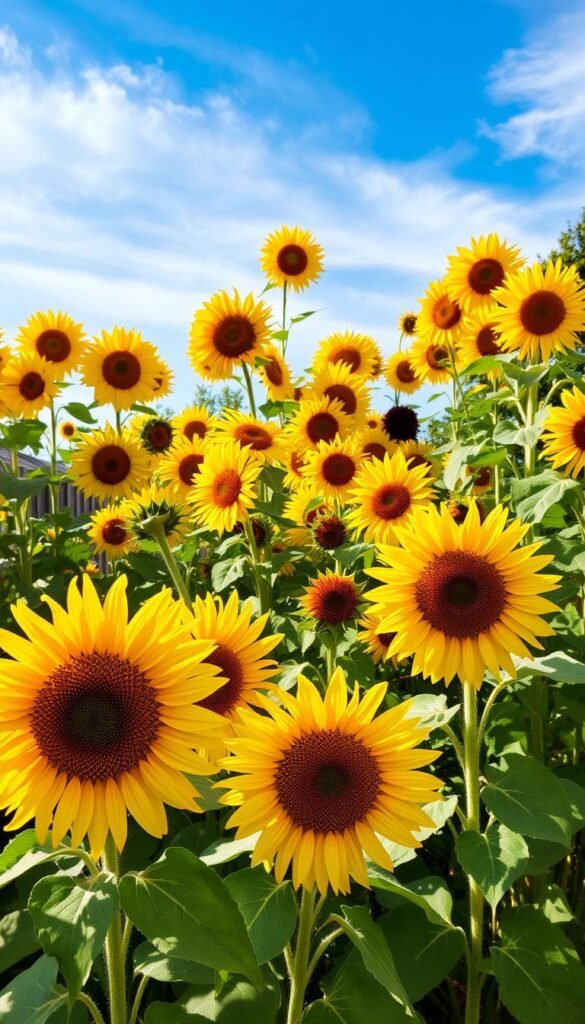
Your plant selection shapes your garden’s personality. With over 70 cultivated types available, each brings distinct textures and functions to outdoor spaces. Let’s explore how different forms can transform your yard’s aesthetic and utility.
Matching Plants to Your Space and Purpose
Size matters when planning your floral display. Compact types like ‘Teddy Bear’ (1-2 feet) thrive in window boxes, while ‘Titan’ specimens tower up to 16 feet. Consider these popular options:
| Type | Height Range | Top Picks | Best Use |
|---|---|---|---|
| Space-Saver | 1-3 ft | Sunspot, Little Becka | Containers, borders |
| Mid-Sized | 4-6 ft | Moulin Rouge, Lemon Queen | Garden beds, cutting |
| Sky-Reacher | 7-16 ft | Skyscraper, Russian Mammoth | Privacy screens |
Beyond golden yellows, modern hybrids offer cinnamon-orange ‘Autumn Beauty’ and wine-red ‘Chianti’. Heat warriors like ‘Soraya’ withstand scorching summers, while pollen-free ‘Sunrich’ types keep indoor arrangements tidy.
Branching forms like ‘Ring of Fire’ yield weeks of cuttable stems. For textural drama, try double-bloomed ‘Teddy Bear’ with its plush petals. Those seeking wildlife visitors should choose traditional seed-producing types over sterile hybrids.
Watering and Fertilizing for Robust Growth
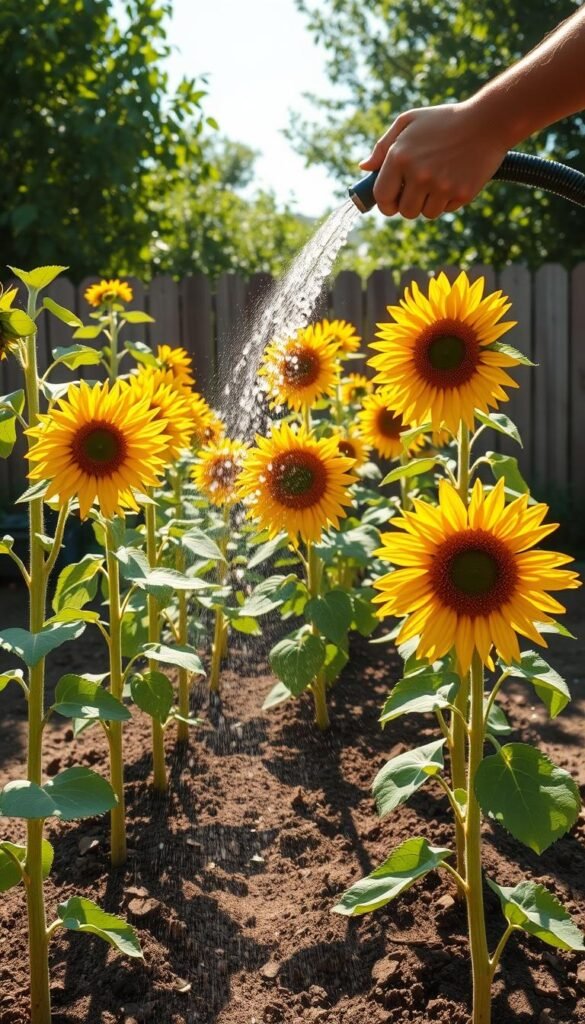
Nourishing your floral giants requires smart hydration strategies paired with nutrient-rich soil solutions. The right balance prevents leggy stems while encouraging those iconic dinner-plate blooms.
Deep Watering Techniques for Established Plants
Young seedlings crave daily sips, but mature specimens prefer weekly feasts. Use the “knuckle test” – if the top 2 inches feel dry, it’s time for a slow, deep soak. A rain gauge helps track the magic 1-inch weekly target.
Try this pro move: Place a tuna can near stems during watering. When it fills, you’ve delivered enough moisture to reach 6-inch root depths. This method builds drought resilience while preventing shallow root systems.
Fertilizer Recommendations: From Compost to Balanced Feed
Mix 2 cups of compost into each planting hole for slow-release nutrition. After 30 days, switch to monthly 10-10-10 liquid feed. Watch for leaf clues – yellowing lower foliage signals nitrogen deficiency, while curled edges suggest overfeeding.
Mulch with straw or shredded bark to lock in moisture. This natural blanket keeps soil temperatures stable and reduces watering needs by up to 25%. Always water at dawn – midday sessions waste 30% to evaporation before roots can drink.
Supporting Your Sunflowers: Staking and Structural Care
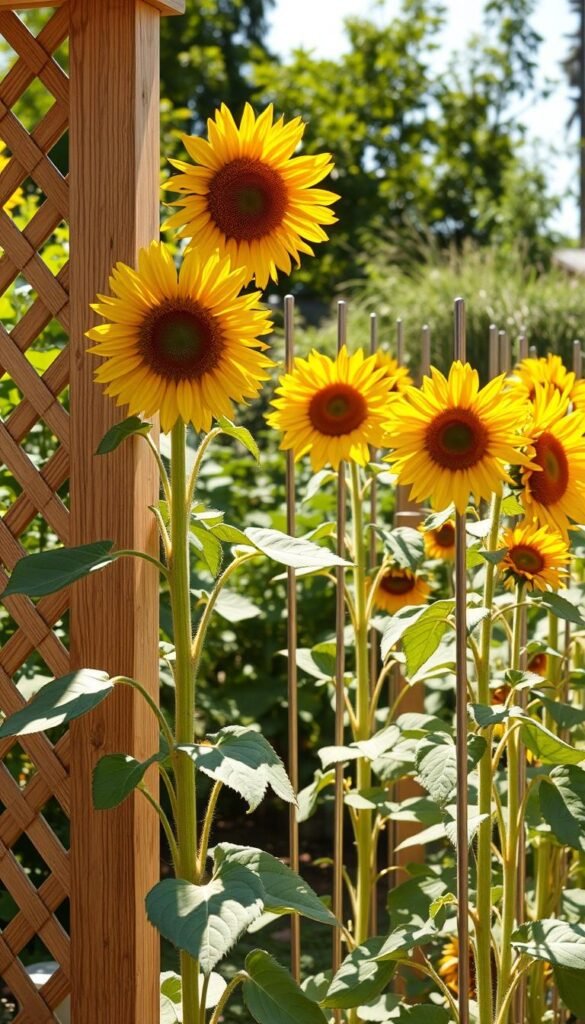
Tall floral giants need strong foundations to showcase their full glory. Proper structural care prevents heartbreak when summer storms hit or heavy blooms nod toward the ground. Let’s explore smart ways to keep your botanical skyscrapers standing proud.
Building Strong Foundations
Timing is everything when setting up support systems. Push stakes into the earth during planting to avoid piercing roots later. Choose materials reaching at least three-quarters of your plant’s expected height – a 9-foot stake for 12-foot varieties works perfectly.
Soft stretchy ties protect stems from cuts as they thicken. Create loose figure-eight loops around the stalk and stake, allowing natural sway. Check ties weekly, adjusting their position as stems expand. For extra-heavy bloomers, position three stakes in a triangle formation around the base.
Watch for early warning signs like slight leaning or stem curvature. These indicate it’s time to add reinforcement. Proactive care helps specimens withstand gusty winds without snapping. Remember – taller varieties often need multiple tie points as they ascend.
Gardeners managing space constraints can use horizontal trellis systems between posts. This approach works wonders for branching types that produce multiple medium-sized blooms. Whatever method you choose, ensure supports blend seamlessly into your garden’s aesthetic.
Handling Common Sunflower Problems and Pests
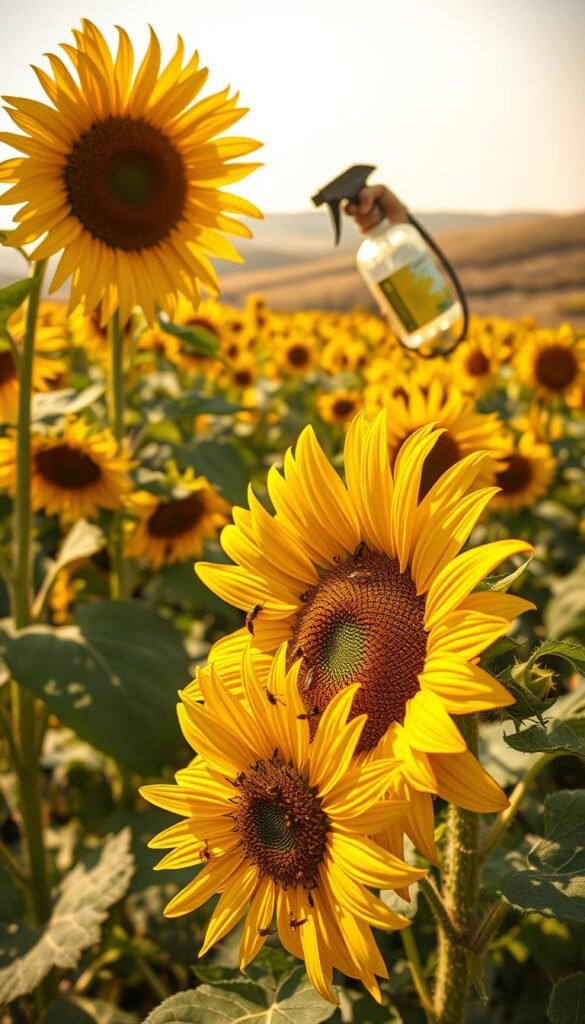
Even the hardiest blooms face challenges that test their sunny disposition. Catching issues early helps your plants recover faster while maintaining their radiant beauty. Let’s explore smart solutions for keeping your floral friends thriving.
Spotting Trouble Before It Spreads
Yellow leaves often reveal watering mistakes. Soggy soil leads to drooping stems, while parched earth causes crispy edges. Check moisture by pushing a finger 2 inches deep – it should feel like a wrung-out sponge. Improve drainage with perlite if puddles linger after storms.
Fungal issues like powdery mildew leave white dust on foliage. Space plants 18-24 inches apart for better airflow. Remove affected leaves immediately and spray with baking soda solution (1 tablespoon per gallon). Rust disease shows as orange spots – treat with neem oil at first sight.
Nature-Friendly Defense Tactics
Aphids cluster on new growth, leaving sticky honeydew. Blast them off with water or introduce ladybugs as natural predators. For spider mites, wipe leaves with diluted castile soap weekly. Deer avoid garlic-sprayed plants – mix 3 crushed cloves in water and mist foliage.
Protect seed heads with cheesecloth when petals drop. Squirrels hate cayenne pepper – sprinkle it around stems. Companion planting with marigolds deters beetles, while mint repels ants. These strategies tackle issues without harming pollinators visiting your flowers.
Enhancing Garden Design with Companion Planting
Transform your outdoor space into a thriving ecosystem through smart plant partnerships. Strategic pairings boost health and beauty while reducing maintenance. You’ll create natural support systems that benefit all your green neighbors.
Powerful Plant Allies
Corn stalks become living trellises for climbing varieties, sharing nutrients through their roots. Bushy bean plants work underground, converting nitrogen into food nearby specimens can use. These partners thrive under similar care routines, making coordination effortless.
Marigolds offer pest protection with their pungent aroma, deterring beetles from prized blooms. Low-growing herbs like basil help conserve soil moisture while attracting pollinators. Avoid pairing with potatoes – they compete for the same nutrients.
This approach maximizes every inch of your plot. Taller varieties shelter tender seedlings from harsh sun, while sprawling ground covers prevent weed growth. Rotate companions yearly to maintain soil balance and prevent disease buildup.
Your efforts yield multiple rewards: fewer chemicals, richer earth, and continuous visual interest. With thoughtful pairings, you’ll craft a self-sustaining display that outshines single-species plantings.

